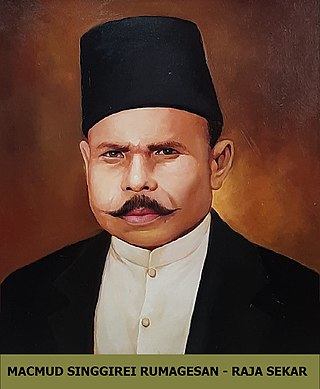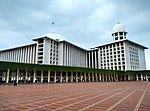
West Papua, formerly Irian Jaya Barat, is an Indonesian province located in the land of Papua. It covers most of the two western peninsulas of the island of New Guinea, the eastern half of the Bird's Head Peninsula and the whole of the Bomberai Peninsula, along with nearby smaller islands. The province is bordered to the north by the Pacific Ocean, to the west by Southwest Papua Province, the Halmahera Sea and the Ceram Sea, to the south by the Banda Sea, and to the east by the province of Central Papua and the Cenderawasih Bay. Manokwari is the province's capital and largest city. With an estimated population of 561,403 in mid-2022, West Papua is the least populous province in Indonesia after Southwest Papua, which was a part of West Papua until separated off in 2022.

Waigeo is an island in the Southwest Papua province of eastern Indonesia. The island is also known as Amberi or Waigiu. It is the largest of the four main islands in the Raja Ampat Islands archipelago, between Halmahera and about 65 kilometres to the northwest coast of New Guinea. The Dampier Strait separates it from Batanta, and the Bougainville Strait from the Kawe Islands to its northwest. The "inner sea" that nearly cleaves the island in two is Mayalibit Bay, also known as the Majoli Gulf.

Raja Ampat, or the Four Kings, is an archipelago located off of the northwest tip of Bird's Head Peninsula, Southwest Papua province, Indonesia. It comprises over 1,500 small islands, cays, and shoals around the four main islands of Misool, Salawati, Batanta, and Waigeo, and the smaller island of Kofiau.

Misool, formerly spelled Mysol or Misol, is one of the four major islands in the Raja Ampat Islands in Southwest Papua, Indonesia. Its area is 2,034 km2. The highest point is 561 m and the main towns are Waigama, located on the island's northwest coast, and Lilinta on the island's southeast coast.

Salawati is one of the four major islands in the Raja Ampat Islands in Southwest Papua, Indonesia. Its area is 1,623 km2. Salawati is separated from New Guinea to the southeast by the Sele Strait, and from Batanta to the north by the Pitt Strait.

Batanta is one of the four major islands in the Raja Ampat Islands in Southwest Papua province, Indonesia. Its area is 479.5 km² and its highest point is 1184 m. The Pitt Strait separates it from Salawati Island, while the Dampier Strait separates it from Waigeo Island.
Bomberai Peninsula is located in the Western New Guinea region. It is south of the Bird's Head Peninsula, and Bintuni Bay separates the two peninsulas. To the west lies the Sebakor Bay and to the south Kamrau Bay. On the southeast Arguni Bay lies between the peninsula and the Bird's Neck Isthmus.

The Sultanate of Tidore was a sultanate in Southeast Asia, centered on Tidore in the Maluku Islands. It was also known as Duko, its ruler carrying the title Kië ma-kolano. Tidore was a rival of the Sultanate of Ternate for control of the spice trade and had an important historical role as binding the archipelagic civilizations of Indonesia to the Papuan world. According to extant historical records, in particular the genealogies of the kings of Ternate and Tidore, the inaugural Tidorese king was Sahjati or Muhammad Naqil whose enthronement is dated 1081 in local tradition. However, the accuracy of the tradition that Tidore emerged as a polity as early as the 11th century is considered debatable. Islam was only made the official state religion in the late 15th century through the ninth King of Tidore, Sultan Jamaluddin. He was influenced by the preachings of Syekh Mansur, originally from Arabia. In the 16th and 17th centuries, the Sultans tended to ally with either Spain or Portugal to maintain their political role but were finally drawn into the Dutch sphere of power in 1663. Despite a period of anti-colonial rebellion in 1780–1810, the Dutch grip on the sultanate increased until decolonization in the 1940s. Meanwhile, Tidore's suzerainty over Raja Ampat and western Papua was acknowledged by the colonial state. In modern times, the sultanate has been revived as a cultural institution.
The Raja Ampat–South Halmahera languages are a branch of Malayo-Polynesian languages of eastern Indonesia. They are spoken on islands in the Halmahera Sea, and on its margins from the south-eastern coast of Halmahera to the Raja Ampat Islands off the western tip of New Guinea.

Maʼya is an Austronesian language of the Raja Ampat islands in Southwest Papua, Indonesia. It is part of the South Halmahera–West New Guinea (SHWNG) subgroup and is spoken by about 6,000 people in coastal villages on the islands Misool, Salawati, and Waigeo, on the boundary between Austronesian and Papuan languages.

Raja Ampat Regency is a regency of Southwest Papua Province of Indonesia. The regency, which was formed by separating the archipelago from Sorong Regency, based on the Law 26 of 2002, was inaugurated on 12 April 2003. It consists of a number of groups of islands situated off the north-west end of West Papua; the four main islands from south to north are Misool, Salawati, Batanta, and Waigeo. At present, the regency covers a land area of 7,559.60 km2, with a total area stated as 67,379.61 km2. It had a population of 42,508 at the 2010 Census and 64,141 at the 2020 Census; the official estimate as at mid 2022 was 66,839. The principal town lies at Waisai on Waigeo Island.
Ambel (Amber), also known as Waigeo after the island where it is primarily spoken, is a heavily Papuan-influenced Austronesian language spoken on the island of Waigeo in the Raja Ampat archipelago near the northwestern tip of West Papua, Indonesia. It is spoken by approximately 1,600 people. It is endangered, as the population is shifting to Papuan Malay and few people born after the year 2000 have any knowledge of the language.
Zainal Abidin was the eighteenth ruler of the Ternate kingdom in Maluku in modern-day Indonesia. His life is only described in sources dating from the 16th century or later. According to these sources he was the first ruler of Ternate to use the title Sultan rather than Kolano, or king, and enacted a number of changes in the government, based on Islamic Law, technically transforming Ternate into an Islamic kingdom.
Sultan Al-Mansur was the second Sultan of Tidore in Maluku islands, who reigned from at least 1512 until 1526. Certain legends associate him with the beginnings of Tidore's rule over the Papuan Islands and western New Guinea. During his reign the first visits by Portuguese and Spanish seafarers took place, which led to grave political and economic consequences for the societies of eastern Indonesia. Trying to preserve his realm in the face of Western encroachment, he finally fell victim to Portuguese enmity.

The Vogelkop–Aru lowland rain forests is a tropical moist forest ecoregion in Indonesia. The ecoregion covers the peninsular lowlands of western New Guinea, along with the Aru Islands and other nearby islands.

The Kingdom of Kaimana or Kingdom of Sran is one of the oldest Muslim kingdoms in West Papua, Indonesia. The kingdom was established by Imaga, with the title Rat Sran Nati Pattimuni, traditionally in 1309.

The Patimburak Old Mosque is a mosque located in Kampung Patimburak, Kokas District, Fakfak, West Papua, Indonesia. The oldest mosque in Fakfak Regency, the mosque is one of the historical legacies of Islam in Papua and has become one of the centers of Islam in Fakfak Regency.
Gurabesi was a legendary Papuan leader from Biak in West New Guinea, present-day Indonesia, who had a large role in tying part of the Papuans to the Islamic Sultanate of Tidore. He is commonly believed to have flourished in the 15th or early 16th century, although other sources point at a later date. His story symbolizes the beginnings of communication between the Malayo-Islamic and Papuan cultures.

Machmud Singgirei Rumagesan was a king of Sekar and pro-integration activist from West Papua. He founded the movement Gerakan Tjendrawasih Revolusioner Irian Barat (GTRIB) in 1953, and became the member of Supreme Advisory Council in 1959. On 10 November 2020, Singgirei Rumagesan was posthumously declared a National Hero of Indonesia for his lifelong efforts to unite West Irian with Indonesia.

Southwest Papua is the 38th province of Indonesia to be created, and was split off from West Papua on 8 December 2022. Despite being named southwest, it is a misnomer and this province is actually located in the northwest edge of Papua. The province comprises the Greater Sorong area which consists of Sorong City, Sorong Regency, South Sorong Regency, Maybrat Regency, Tambrauw Regency, and Raja Ampat Regency. The Bill (RUU) on the Establishment of the Southwest Papua Province was passed into law and therefore it became the 38th province in Indonesia.














